Jiajia Guo
AI-Driven Subcarrier-Level CQI Feedback
Dec 22, 2025Abstract:The Channel Quality Indicator (CQI) is a fundamental component of channel state information (CSI) that enables adaptive modulation and coding by selecting the optimal modulation and coding scheme to meet a target block error rate. While AI-enabled CSI feedback has achieved significant advances, especially in precoding matrix index feedback, AI-based CQI feedback remains underexplored. Conventional subband-based CQI approaches, due to coarse granularity, often fail to capture fine frequency-selective variations and thus lead to suboptimal resource allocation. In this paper, we propose an AI-driven subcarrier-level CQI feedback framework tailored for 6G and NextG systems. First, we introduce CQInet, an autoencoder-based scheme that compresses per-subcarrier CQI at the user equipment and reconstructs it at the base station, significantly reducing feedback overhead without compromising CQI accuracy. Simulation results show that CQInet increases the effective data rate by 7.6% relative to traditional subband CQI under equivalent feedback overhead. Building on this, we develop SR-CQInet, which leverages super-resolution to infer fine-grained subcarrier CQI from sparsely reported CSI reference signals (CSI-RS). SR-CQInet reduces CSI-RS overhead to 3.5% of CQInet's requirements while maintaining comparable throughput. These results demonstrate that AI-driven subcarrier-level CQI feedback can substantially enhance spectral efficiency and reliability in future wireless networks.
Deep Learning-based Position-domain Channel Extrapolation for Cell-Free Massive MIMO
Jul 23, 2025Abstract:To reduce channel acquisition overhead, spatial, time, and frequency-domain channel extrapolation techniques have been widely studied. In this paper, we propose a novel deep learning-based Position-domain Channel Extrapolation framework (named PCEnet) for cell-free massive multiple-input multiple-output (MIMO) systems. The user's position, which contains significant channel characteristic information, can greatly enhance the efficiency of channel acquisition. In cell-free massive MIMO, while the propagation environments between different base stations and a specific user vary and their respective channels are uncorrelated, the user's position remains constant and unique across all channels. Building on this, the proposed PCEnet framework leverages the position as a bridge between channels to establish a mapping between the characteristics of different channels, thereby using one acquired channel to assist in the estimation and feedback of others. Specifically, this approach first utilizes neural networks (NNs) to infer the user's position from the obtained channel. {The estimated position, shared among BSs through a central processing unit (CPU)}, is then fed into an NN to design pilot symbols and concatenated with the feedback information to the channel reconstruction NN to reconstruct other channels, thereby significantly enhancing channel acquisition performance. Additionally, we propose a simplified strategy where only the estimated position is used in the reconstruction process without modifying the pilot design, thereby reducing latency. Furthermore, we introduce a position label-free approach that infers the relative user position instead of the absolute position, eliminating the need for ground truth position labels during the localization NN training. Simulation results demonstrate that the proposed PCEnet framework reduces pilot and feedback overheads by up to 50%.
Out-of-Band Modality Synergy Based Multi-User Beam Prediction and Proactive BS Selection with Zero Pilot Overhead
Jun 18, 2025Abstract:Multi-user millimeter-wave communication relies on narrow beams and dense cell deployments to ensure reliable connectivity. However, tracking optimal beams for multiple mobile users across multiple base stations (BSs) results in significant signaling overhead. Recent works have explored the capability of out-of-band (OOB) modalities in obtaining spatial characteristics of wireless channels and reducing pilot overhead in single-BS single-user/multi-user systems. However, applying OOB modalities for multi-BS selection towards dense cell deployments leads to high coordination overhead, i.e, excessive computing overhead and high latency in data exchange. How to leverage OOB modalities to eliminate pilot overhead and achieve efficient multi-BS coordination in multi-BS systems remains largely unexplored. In this paper, we propose a novel OOB modality synergy (OMS) based mobility management scheme to realize multi-user beam prediction and proactive BS selection by synergizing two OOB modalities, i.e., vision and location. Specifically, mobile users are initially identified via spatial alignment of visual sensing and location feedback, and then tracked according to the temporal correlation in image sequence. Subsequently, a binary encoding map based gain and beam prediction network (BEM-GBPN) is designed to predict beamforming gains and optimal beams for mobile users at each BS, such that a central unit can control the BSs to perform user handoff and beam switching. Simulation results indicate that the proposed OMS-based mobility management scheme enhances beam prediction and BS selection accuracy and enables users to achieve 91% transmission rates of the optimal with zero pilot overhead and significantly improve multi-BS coordination efficiency compared to existing methods.
AI for CSI Prediction in 5G-Advanced and Beyond
Apr 17, 2025Abstract:Artificial intelligence (AI) is pivotal in advancing fifth-generation (5G)-Advanced and sixth-generation systems, capturing substantial research interest. Both the 3rd Generation Partnership Project (3GPP) and leading corporations champion AI's standardization in wireless communication. This piece delves into AI's role in channel state information (CSI) prediction, a sub-use case acknowledged in 5G-Advanced by the 3GPP. We offer an exhaustive survey of AI-driven CSI prediction, highlighting crucial elements like accuracy, generalization, and complexity. Further, we touch on the practical side of model management, encompassing training, monitoring, and data gathering. Moreover, we explore prospects for CSI prediction in future wireless communication systems, entailing integrated design with feedback, multitasking synergy, and predictions in rapid scenarios. This article seeks to be a touchstone for subsequent research in this burgeoning domain.
AdapCsiNet: Environment-Adaptive CSI Feedback via Scene Graph-Aided Deep Learning
Apr 15, 2025



Abstract:Accurate channel state information (CSI) is critical for realizing the full potential of multiple-antenna wireless communication systems. While deep learning (DL)-based CSI feedback methods have shown promise in reducing feedback overhead, their generalization capability across varying propagation environments remains limited due to their data-driven nature. Existing solutions based on online training improve adaptability but impose significant overhead in terms of data collection and computational resources. In this work, we propose AdapCsiNet, an environment-adaptive DL-based CSI feedback framework that eliminates the need for online training. By integrating environmental information -- represented as a scene graph -- into a hypernetwork-guided CSI reconstruction process, AdapCsiNet dynamically adapts to diverse channel conditions. A two-step training strategy is introduced to ensure baseline reconstruction performance and effective environment-aware adaptation. Simulation results demonstrate that AdapCsiNet achieves up to 46.4% improvement in CSI reconstruction accuracy and matches the performance of online learning methods without incurring additional runtime overhead.
Prompt-Enabled Large AI Models for CSI Feedback
Jan 18, 2025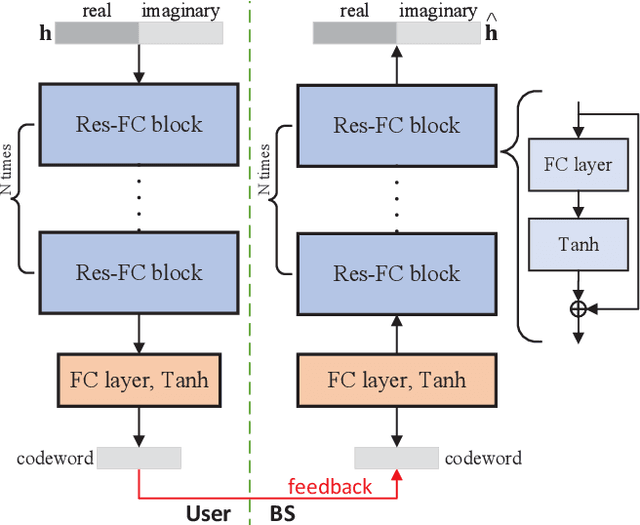
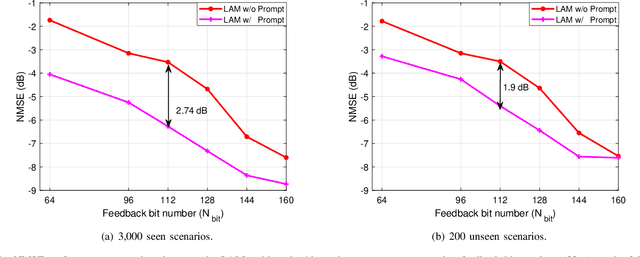
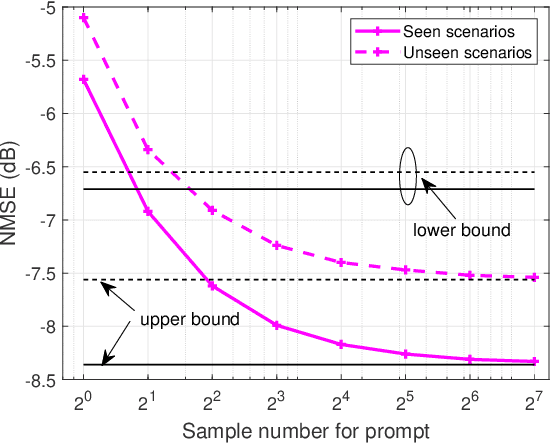
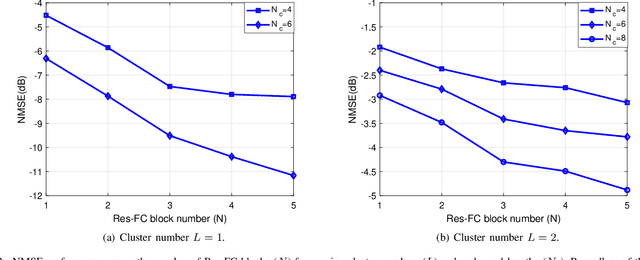
Abstract:Artificial intelligence (AI) has emerged as a promising tool for channel state information (CSI) feedback. While recent research primarily focuses on improving feedback accuracy through novel architectures, the underlying mechanisms of AI-based CSI feedback remain unclear. This study investigates these mechanisms by analyzing performance across diverse datasets and reveals that superior feedback performance stems from the strong fitting capabilities of AI models and their ability to leverage environmental knowledge. Building on these findings, we propose a prompt-enabled large AI model (LAM) for CSI feedback. The LAM employs powerful transformer blocks and is trained on extensive datasets from various scenarios. To further enhance reconstruction quality, the channel distribution -- represented as the mean of channel magnitude in the angular domain -- is incorporated as a prompt within the decoder. Simulation results confirm that the proposed prompt-enabled LAM significantly improves feedback accuracy and generalization performance while reducing data collection requirements in new scenarios.
Efficient Deep Learning-based Cascaded Channel Feedback in RIS-Assisted Communications
Sep 12, 2024Abstract:In the realm of reconfigurable intelligent surface (RIS)-assisted communication systems, the connection between a base station (BS) and user equipment (UE) is formed by a cascaded channel, merging the BS-RIS and RIS-UE channels. Due to the fixed positioning of the BS and RIS and the mobility of UE, these two channels generally exhibit different time-varying characteristics, which are challenging to identify and exploit for feedback overhead reduction, given the separate channel estimation difficulty. To address this challenge, this letter introduces an innovative deep learning-based framework tailored for cascaded channel feedback, ingeniously capturing the intrinsic time variation in the cascaded channel. When an entire cascaded channel has been sent to the BS, this framework advocates the feedback of an efficient representation of this variation within a subsequent period through an extraction-compression scheme. This scheme involves RIS unit-grained channel variation extraction, followed by autoencoder-based deep compression to enhance compactness. Numerical simulations confirm that this feedback framework significantly reduces both the feedback and computational burdens.
Deep Learning-based CSI Feedback in Wi-Fi Systems
Jul 08, 2024



Abstract:In Wi-Fi systems, channel state information (CSI) plays a crucial role in enabling access points to execute beamforming operations. However, the feedback overhead associated with CSI significantly hampers the throughput improvements. Recent advancements in deep learning (DL) have transformed the approach to CSI feedback in cellular systems. Drawing inspiration from the successes witnessed in the realm of mobile communications, this paper introduces a DL-based CSI feedback framework, named EFNet, tailored for Wi-Fi systems. The proposed framework leverages an autoencoder to achieve precise feedback with minimal overhead. The process involves the station utilizing the encoder to compress and quantize a series of matrices into codeword bit streams, which are then fed back to the access point. Subsequently, the decoder installed at the AP reconstructs beamforming matrices from these bit streams. We implement the EFNet system using standard Wi-Fi equipment operating in the 2.4 GHz band. Experimental findings in an office environment reveal a remarkable 80.77% reduction in feedback overhead compared to the 802.11ac standard, alongside a significant boost in net throughput of up to 30.72%.
Fluid Antenna for Mobile Edge Computing
Mar 18, 2024



Abstract:In the evolving environment of mobile edge computing (MEC), optimizing system performance to meet the growing demand for low-latency computing services is a top priority. Integrating fluidic antenna (FA) technology into MEC networks provides a new approach to address this challenge. This letter proposes an FA-enabled MEC scheme that aims to minimize the total system delay by leveraging the mobility of FA to enhance channel conditions and improve computational offloading efficiency. By establishing an optimization problem focusing on the joint optimization of computation offloading and antenna positioning, we introduce an alternating iterative algorithm based on the interior point method and particle swarm optimization (IPPSO). Numerical results demonstrate the advantages of our proposed scheme compared to traditional fixed antenna positions, showing significant improvements in transmission rates and reductions in delays. The proposed IPPSO algorithm exhibits robust convergence properties, further validating the effectiveness of our method.
Achievable Rate Analysis and Optimization of Double-RIS Assisted Spatially Correlated MIMO with Statistical CSI
Mar 12, 2024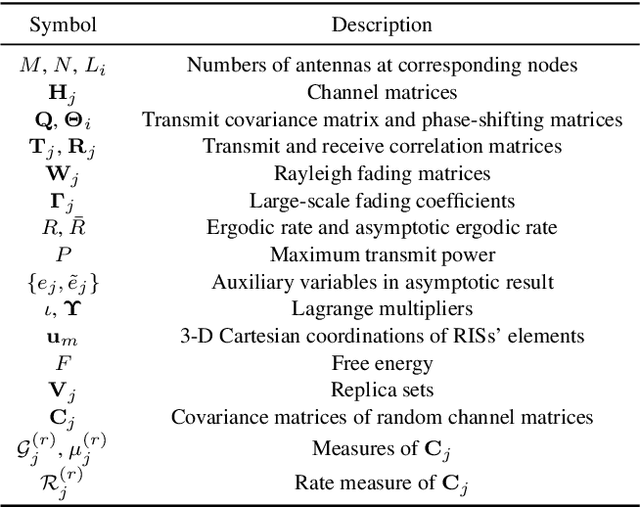
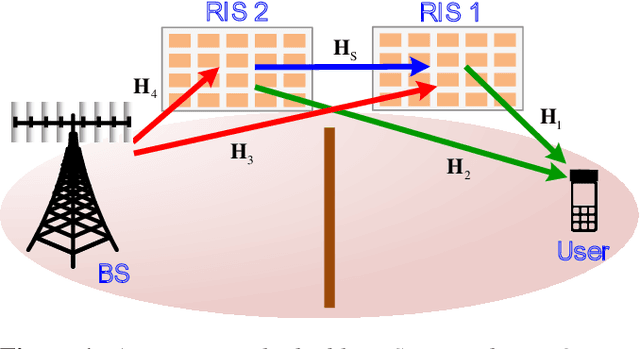
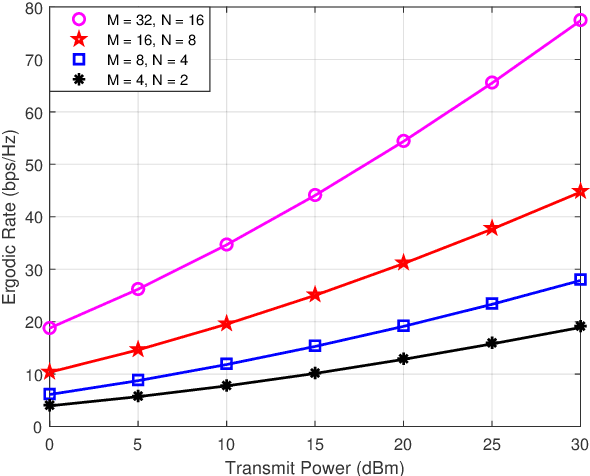
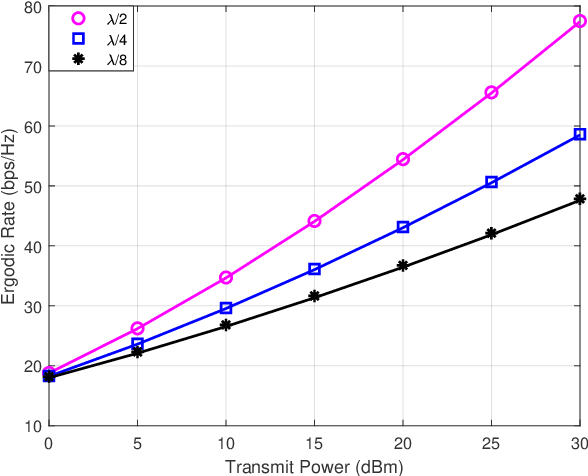
Abstract:Reconfigurable intelligent surface (RIS) is a novel meta-material which can form a smart radio environment by dynamically altering reflection directions of the impinging electromagnetic waves. In the prior literature, the inter-RIS links which also contribute to the performance of the whole system are usually neglected when multiple RISs are deployed. In this paper we investigate a general double-RIS assisted multiple-input multiple-output (MIMO) wireless communication system under spatially correlated non line-of-sight propagation channels, where the cooperation of the double RISs is also considered. The design objective is to maximize the achievable ergodic rate based on full statistical channel state information (CSI). Specifically, we firstly present a closed-form asymptotic expression for the achievable ergodic rate by utilizing replica method from statistical physics. Then a full statistical CSI-enabled optimal design is proposed which avoids high pilot training overhead compared to instantaneous CSI-enabled design. To further reduce the signal processing overhead and lower the complexity for practical realization, a common-phase scheme is proposed to design the double RISs. Simulation results show that the derived asymptotic ergodic rate is quite accurate even for small-sized antenna arrays. And the proposed optimization algorithm can achieve substantial gain at the expense of a low overhead and complexity. Furthermore, the cooperative double-RIS assisted MIMO framework is proven to achieve superior ergodic rate performance and high communication reliability under harsh propagation environment.
 Add to Chrome
Add to Chrome Add to Firefox
Add to Firefox Add to Edge
Add to Edge